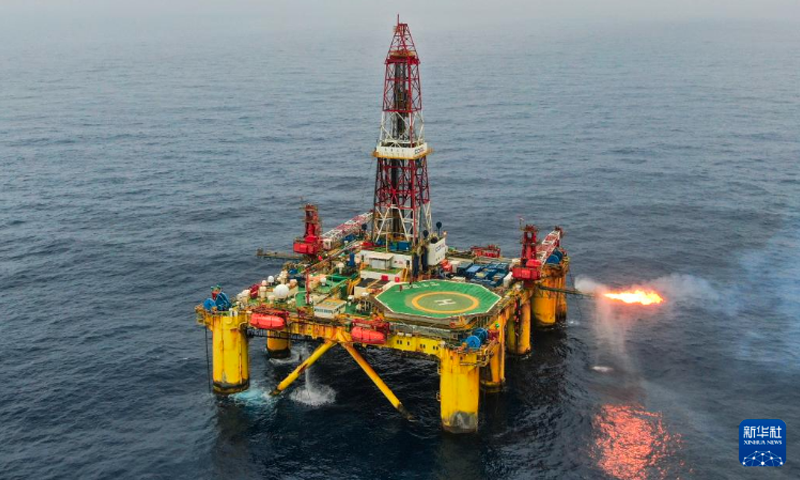
The Nanhai 2 oil rig conducts drilling operations in the waters of Huizhou 19-6 oilfield. Photo: Xinhua
China has discovered large-scale integrated clastic oilfield in deep to ultra-deep layers for the first time in South China Sea, marking a breakthrough in China's offshore oil exploration. An expert told the Global Times that it could alleviate the country's oil and gas resource constraints, and holds significant implications for the future production potential of oilfields in China.
The China National Offshore Oil Corporation (CNOOC) announced on Monday that it has discovered Huizhou 19-6 oilfield, a major oilfield in the eastern South China Sea, with proven reserves exceeding 100 million tons, according to Xinhua News Agency.
Situated about 170 kilometers from Shenzhen in South China's Guangdong Province, the oilfield sits at an average water depth of 100 meters. Test drilling has yielded a daily production of 413 barrels of crude oil and 68,000 cubic meters of natural gas, demonstrating its potential, according to Xinhua.
"The South China Sea is a large marine basin with geological conditions conducive to the formation of such clastic oilfield in deep to ultra-deep layers," Wang Yamin, a professor at the Shandong University's School of Oceanography, told the Global Times. "Historically, China has had relatively limited oilfield reserves. The current global trend is shifting toward the development of shale and clastic rock oilfields. Therefore, the latest discovery holds significant implications for the future distribution and production potential of oilfields in China."
"Also, the discovery could alleviate the country's oil and gas resource constraints and reduce China's dependence on foreign oil, though extensive exploration of unknown areas is still required," Wang said.
According to CNOOC, offshore oil and gas exploration in deep to ultra-deep layers faces multiple challenges, including high temperatures, high pressures and complex conditions, Xinhua reported.
Meanwhile, clastic reservoirs, an important component of deep-sea hydrocarbon deposits, generally have low permeability, making the identification of large oil and gas fields more difficult, reported Xinhua.
"China's offshore oil extraction technology has not been under development for very long. While shallow-water oil extraction in the Bohai Sea is already well-established, and multiple extraction sites exist in the South China Sea, with many technical challenges remain unresolved in the deeper regions," Wang added.
"This discovery, along with potential future findings, will further drive advancements in deep-sea exploration and extraction technology."
According to Xinhua, Peng Guangrong, a geologist at CNOOC's Shenzhen branch, noted that 60 percent of the world's newly discovered oil and gas reserves have come from deep layers. With abundant resources and a low level of exploration, deep to ultra-deep layers are expected to drive future growth in oil and gas reserves and production.
China's oil and gas exploration in the eastern South China Sea has seen consecutive breakthroughs, with oilfields exceeding 100 million tons in reserves discovered for two straight years, CNOOC's CEO Zhou Xinhuai told Xinhua.
In December 2024, CNOOC released a report about China offshore energy development. The report highlights that China's offshore oil and gas production reached a new record high, with major breakthroughs in exploration and development. Deepwater oil and gas technologies and equipment achieved systematic advancements, while the utilization rate of offshore oil and gas engineering equipment led the world.




